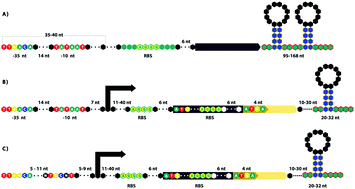Consensus architecture of promoters and transcription units in Escherichia coli: design principles for synthetic biology†
Abstract
Genetic information in genomes is ordered, arranged in such a way that it constitutes a code, the so-called cis regulatory code. The regulatory machinery of the cell, termed trans-factors, decodes and expresses this information. In this way, genomes maintain a potential repertoire of genetic programs, parts of which are executed depending on the presence of active regulators in each condition. These genetic programs, executed by the regulatory machinery, have functional units in the genome delimited by punctuation-like marks. In genetic terms, these informational phrases correspond to transcription units, which are the minimal genetic information expressed consistently from initiation to termination marks. Between the start and final punctuation marks, additional marks are present that are read by the transcriptional and translational machineries. In this work, we look at all the experimentally described and predicted genetic elements in the bacterium Escherichia coli K-12 MG1655 and define a comprehensive architectural organization of transcription units to reveal the natural genome-design and to guide the construction of synthetic genetic programs.



 Please wait while we load your content...
Please wait while we load your content...